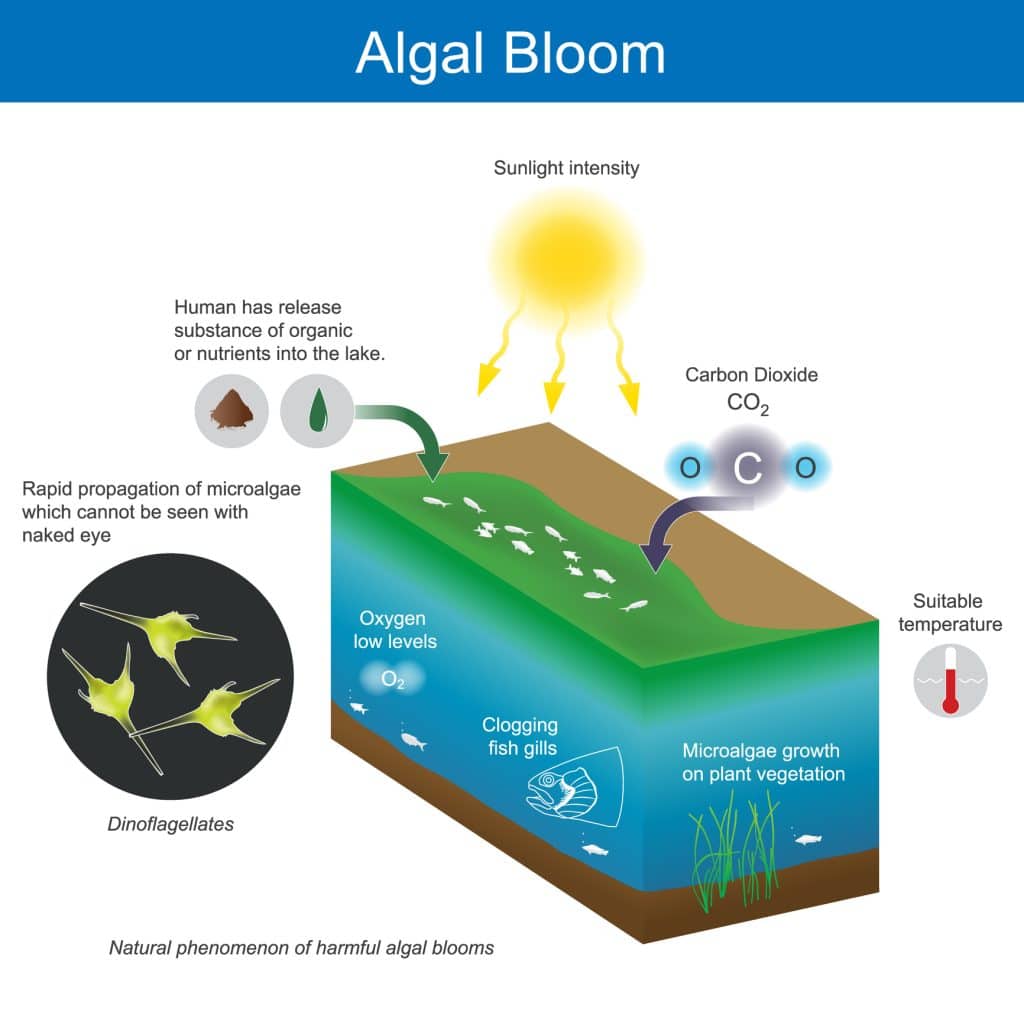How Algae Produce Oxygen
Algae, like land plants, contain chloroplasts with chlorophyll pigments that absorb sunlight. Chloroplasts are found within plant cells and algal cells, and are responsible for photosynthesis. Algae, like green plants, use chlorophyll to capture sunlight and produce oxygen. During daylight hours, these microorganisms transform carbon dioxide and water into glucose for growth. All appreciable photosynthesis occurs in the surface layer that absorbs 99% of the light (euphotic zone). It is important to measure and evaluate water transparency in connection with oxygen relations. This process produces oxygen as a by-product. Moreover, oxygen is critical for aquatic life such as fish, invertebrates, and beneficial bacteria, as well as for maintaining the overall balance of the Earth’s oxygen supply. Oxygen production by algae is the most important phenomenon.
It is estimated that algae, especially microscopic phytoplankton in the oceans, produce over 50% of the world’s oxygen—some estimates suggest as much as 70%. The oceans generate over half of the world’s oxygen supply. With oceans covering 71% of the Earth’s surface, the contribution of marine algae to atmospheric oxygen surpasses that of terrestrial plants. The ocean is home to many microalgal species, including Chlorella vulgaris, which are highly efficient at producing oxygen. Among phytoplankton, Prochlorococcus, the smallest photosynthetic organism, produces the most oxygen in the ocean due to its abundance and efficiency.
Factors That Influence Algal Growth
Algal growth, and the resulting oxygen production depends on a delicate balance of environmental factors. Light is one of the most critical elements, as it powers the process of photosynthesis that allows algae to convert carbon dioxide and water into oxygen. The intensity and duration of sunlight directly affect how efficiently algae produce oxygen, with most species thriving under specific light conditions. Temperature is another key factor; each algal species has an optimal temperature range that supports maximum growth and photosynthetic activity. When temperatures stray too far from this range, algal growth and oxygen output can decline.
Nutrient availability, particularly nitrogen and phosphorus, also plays a major role in algal growth. These nutrients act as essential building blocks for cell development and energy production. When nutrients are abundant, especially in ponds, lakes, and oceans, algal populations can expand rapidly, increasing the amount of oxygen produced during photosynthesis. However, too many nutrients can lead to excessive algal growth, which may disrupt oxygen levels and aquatic ecosystems.
Carbon dioxide concentration is equally important, as it is a fundamental component of the photosynthetic process. Higher levels of carbon dioxide can stimulate algal growth and boost oxygen production, provided other conditions are favorable. Additional factors such as water movement, salinity, and pH can also influence how well algae grow and produce oxygen. Understanding these factors is essential for managing algal growth in natural and engineered environments, ensuring that algae continue to support healthy oxygen levels in water bodies around the world.
Why Oxygen from Algae Matters
Healthy levels of dissolved oxygen in water bodies are essential for aquatic ecosystems to thrive. Balanced algal populations support these oxygen levels, aiding in fish respiration, organic matter breakdown, and overall water quality. Animals in aquatic environments, including fish and invertebrates, rely on the oxygen produced by algae to breathe.
However, when algae grow excessively, typically due to nutrient pollution from nitrogen and phosphorus they form harmful algal blooms (HABs). Algae blooms can be observed in both freshwater and marine water bodies, and too much algae can lead to oxygen depletion. Algae can also be utilized in wastewater treatment processes to remove nutrients such as nitrogen and phosphorus.
These blooms can upset the oxygen balance: while algae produce oxygen during the day, they consume oxygen at night. During daylight hours, algae typically produce more oxygen than they consume, but this balance can shift under certain environmental conditions. If too many algae die and decompose, oxygen can be rapidly depleted, leading to hypoxic or anoxic conditions and causing fish kills and ecosystem collapse. In short, dense algal blooms can cause stratification in water bodies, limiting oxygen production in deeper layers.
Measuring the Oxygen Output of Algae
Accurately measuring the oxygen output of algae is essential for understanding their impact on aquatic ecosystems and their potential for applications like biofuel production. Scientists use a variety of methods to assess how much oxygen algae produce. Dissolved oxygen meters are commonly used to measure the concentration of oxygen dissolved in water. This provides real-time data on oxygen levels that support aquatic organisms. Oxygen sensors can be placed in water or air to monitor changes in oxygen concentrations, helping researchers track the effects of algal growth on the environment. Phytoplankton in the ocean produce at least 50% of the oxygen in Earth’s atmosphere.
Photosynthesis measurement systems offer another approach, allowing scientists to estimate oxygen production by monitoring the rate of photosynthetic activity in algal cultures or natural water bodies. Techniques such as chlorophyll fluorescence can also be used to gauge the efficiency of photosynthesis and the amount of oxygen produced by different algal species. By combining these methods, researchers can determine how much oxygen is generated under various conditions, identify factors that lead to oxygen depletion, and develop strategies to maintain healthy oxygen levels for aquatic life.
Understanding the oxygen output of algae is not only important for ecosystem management but also for optimizing algal growth in biofuel production and other sustainable applications. By monitoring and managing oxygen production, scientists and environmental managers can help prevent hypoxia, support aquatic organisms, and harness the full potential of algae as natural oxygen generators.
The Double-Edged Nature of Algal Blooms
Under the right conditions, algae are highly beneficial. But when their growth becomes excessive, they disrupt aquatic systems. Algal blooms:
- Block sunlight from reaching submerged plants
- Reduce oxygen levels through decomposition
- Alter aquatic food webs
- Produce foul odors and affect water taste

Even though algae continue to produce oxygen during the day, their nighttime respiration and decay can cause sharp oxygen declines, especially in stagnant or shallow waters. These oxygen imbalances degrade water quality and can lead to the formation of “dead zones” where aquatic life cannot survive.
Harnessing Algae Safely: The Role of Technology
To maintain the benefits of algae while preventing their harmful effects, it’s important to adopt technologies. Innovative technologies like LG Sonic’s ultrasound treatment offer a sustainable solution. LG Sonic systems use environmentally safe ultrasonic waves to control algae growth at the cellular level—without the use of chemicals. This technology:
- Reduces up to 95% of algal blooms
- Improves water clarity and oxygen stability
- Prevents filter clogging and taste or odor issues
- Protects aquatic biodiversity by avoiding chemical disturbance
Advanced water treatment technologies, such as membrane bioreactors, are increasingly integrating algae and aerobic bacteria. This is to enhance both oxygen production and water quality. In these hybrid systems, high levels of nutrient removal and oxygen production have been achieved by combining algae with membrane filtration technology. Ongoing research is focused on optimizing these systems for greater sustainability and operational efficiency.
By keeping algal populations in check, LG Sonic ensures that oxygen production by algae continues without triggering the negative cascade of algal overgrowth and oxygen depletion.
Looking Forward: Algae for Sustainability
Algae are also being explored as a tool for resource recovery, including biofuel production and carbon capture. Specific microalgal species, such as Chlorella vulgaris, are increasingly used in these applications. This is due to their efficient nutrient utilization and growth characteristics. Their ability to convert sunlight and CO2 into biomass and oxygen positions them as sustainable in environmental and energy solutions. Optimizing light conditions, including the use of red light, can further enhance the efficiency of algae in producing oxygen. In well-managed systems, algae not only enhance oxygen levels but also offer economic and ecological value. The relationship between algae and plants highlights how plant cells, through photosynthesis, play a crucial role in sustaining Earth’s atmosphere.
Are you facing water quality issues?
Learn more about the Monitoring Buoy that provides continuous, real-time data on key parameters such as chlorophyll-a, phycocyanin, temperature, and more, helping you make smarter decisions.
